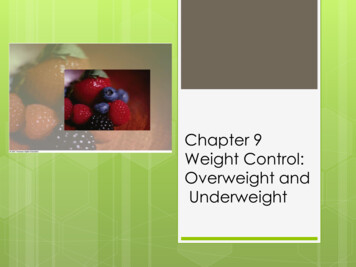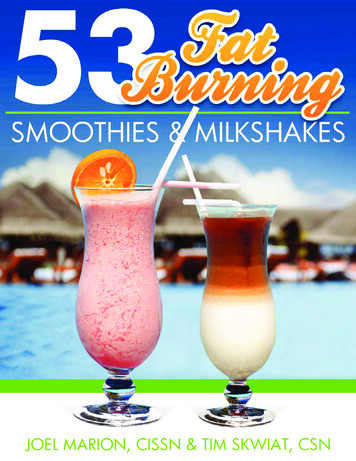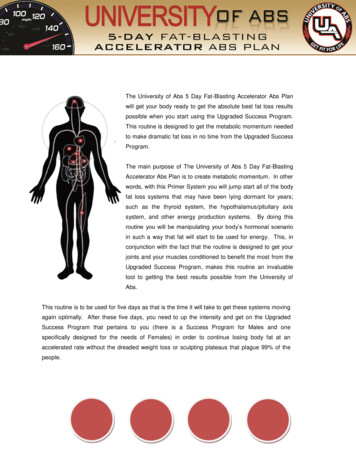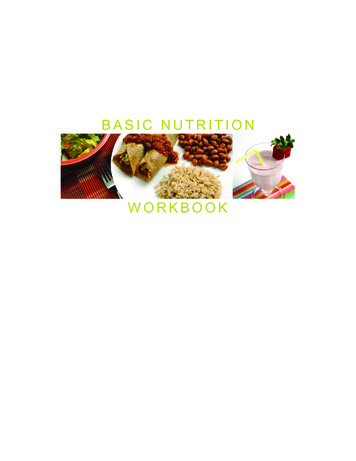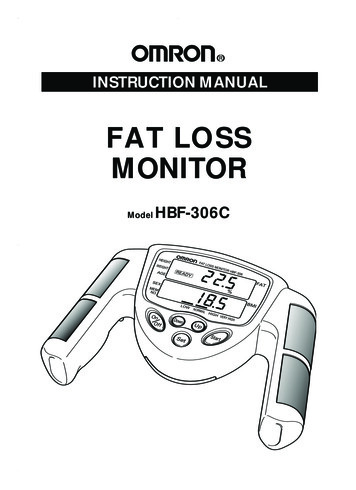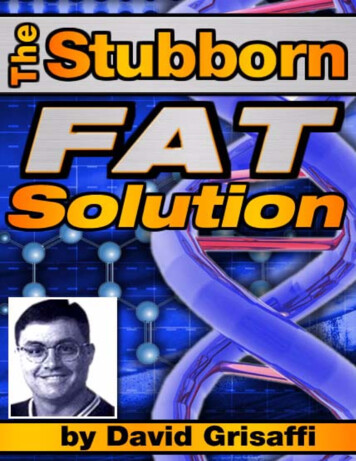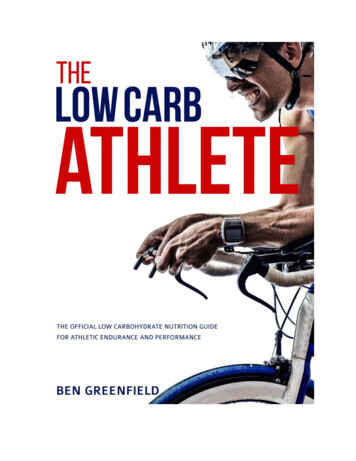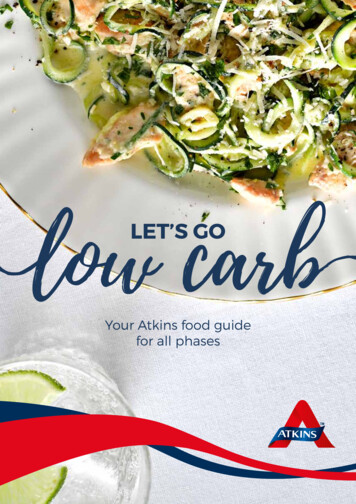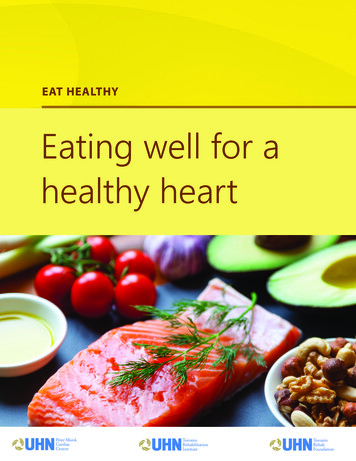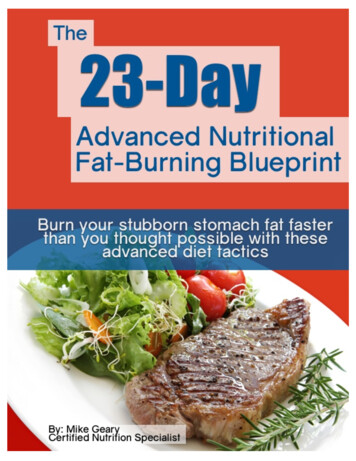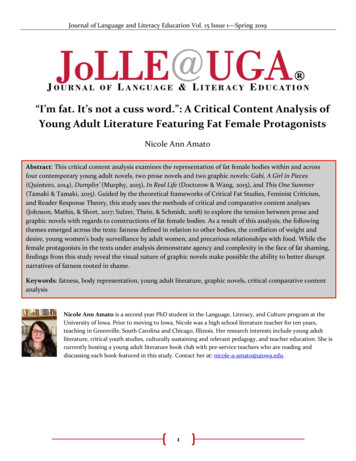
Transcription
Journal of Language and Literacy Education Vol. 15 Issue 1—Spring 2019“I’m fat. It’s not a cuss word.”: A Critical Content Analysis ofYoung Adult Literature Featuring Fat Female ProtagonistsNicole Ann AmatoAbstract: This critical content analysis examines the representation of fat female bodies within and acrossfour contemporary young adult novels, two prose novels and two graphic novels: Gabi, A Girl in Pieces(Quintero, 2014), Dumplin’ (Murphy, 2015), In Real Life&(Doctorow & Wang, 2015), and This One Summer(Tamaki & Tamaki, 2015). Guided by the theoretical frameworks of Critical Fat Studies, Feminist Criticism,and Reader Response Theory, this study uses the methods of critical and comparative content analyses(Johnson, Mathis, & Short, 2017; Sulzer, Thein, & Schmidt, 2018) to explore the tension between prose andgraphic novels with regards to constructions of fat female bodies. As a result of this analysis, the followingthemes emerged across the texts: fatness defined in relation to other bodies, the conflation of weight anddesire, young women’s body surveillance by adult women, and precarious relationships with food. While thefemale protagonists in the texts under analysis demonstrate agency and complexity in the face of fat shaming,findings from this study reveal the visual nature of graphic novels make possible the ability to better disruptnarratives of fatness rooted in shame.Keywords: fatness, body representation, young adult literature, graphic novels, critical comparative contentanalysisNicole Ann Amato is a second year PhD student in the Language, Literacy, and Culture program at theUniversity of Iowa. Prior to moving to Iowa, Nicole was a high school literature teacher for ten years,teaching in Greenville, South Carolina and Chicago, Illinois. Her research interests include young adultliterature, critical youth studies, culturally sustaining and relevant pedagogy, and teacher education. She iscurrently hosting a young adult literature book club with pre-service teachers who are reading anddiscussing each book featured in this study. Contact her at: nicole-a-amato@uiowa.edu.1
Journal of Language and Literacy Education Vol. 15 Issue 1—Spring 2019Purpose1Ashley’s narrative arc is still defined by herrelationship (and her family’s relationship) with herweight.Fat women in fiction are often the friend, thesidekick, the comic relief, even the villain(Jensen, 2015; Parsons, 2016; Younger, 2006;).In her essay “The Trash Heap Has Spoken:The Power and Danger of Women Who Take UpSpace,” Carmen Maria Machado (2017) exploresthese dynamics in storytelling by centering Marjoryfrom Fraggle Rock and Ursula from The LittleMermaid in her ode to fat female bodies. Machadowrites of fat women in fiction: “They’re neverromantic leads, or heroes. They never get to just be.It’s like writers can’t imagine fat women having sexor agency or complex lives.” Although there hasbeen an increase in centering fat bodies as leadcharacters in young adult fiction, many of thesetexts position their fat characters in conflict withtheir body, a conflict they must overcome to findhappiness, success, and internal peace (Jensen, 2015;Parsons, 2016; Quick, 2008).As a reader, as a teacher of literature, as a teacher topre-service educators, and as a fat woman, I seekmore than representation of fat bodies in literature;I want to see, as Machado (2017) muses, fat womenwho “get to just be.” This is not to say I want toignore or silence the very real ways in which fatwomen experience marginalization and degradationas they move through the world, but instead I wantto see young adult literature that disrupts narrativesof fatness rooted in shame as a way for youngreaders to imagine a world in which one does notneed to equate fatness with shame, unhappiness, oran unhealthy lifestyle. I want readers to see fatwomen, even if it is in fiction, living joyfully, andeither free from or actively resisting the societalstigmas associated with fatness. For these reasons,my research on young adult literature with fatfemale protagonists is guided by the followingresearch questions:For example, the protagonist Ashley in FuturePerfect (Larsen, 2015) is described as being contentwith her body despite the pressure from her familyto lose weight. The narrative arc of the story followsAshley taking bribes from her grandmother to loseweight in exchange for trips, clothes, and ultimatelyher tuition to Harvard. The book cover is adornedwith an image of two different dresses hanging fromthe words future and perfect, the tinier dress with asmaller waistline is hanging from the word future.The book jacket reads, “They all believe Ashleycould be her best self if she would just listen tothem. But what’s a girl to do when the reflection inher mirror seems to bother everyone but her?” Insome ways this book is meeting Machado’s call forfat characters with agency and complexity; however,1.How do young adult writers and graphicnovelists construct a character’s fatness?What textual and visual resources does awriter utilize to communicate the fatness ofa character to their readers, and what dothese constructions reveal about thenormalization or othering of fatness?2. In what ways can the medium of young adultgraphic novels disrupt narratives of fatwomen in conflict with their bodies?These questions were formulated by considering therelationship between textual and visual features1I acknowledge that there is a gender spectrum and thatmyriad pronouns exist that I can use when referring toindividuals in my writing. Throughout this article I willuse “he” to refer to individuals who identify as male, “she”to refer to individuals who identify as female, and “ze” forindividuals who identify as gender-neutral. I haveselected these pronouns because I believe they are morefamiliar for a diverse audience of readers.2
Journal of Language and Literacy Education Vol. 15 Issue 1—Spring 2019within young adult fiction, and the implications forunderstanding how fat bodies are constructed in astory. A traditional prose novel relies on the writtenword to construct a character’s fatness (i.e. dialoguebetween characters, narrator description, peritextualfeatures such a book summaries, reviews, andauthor biographies); whereas, a graphic novel offersreaders visual and textual elements to construct acharacter’s body. However, not all prose novels aredevoid of visual imagery. In fact, many include bookcover imagery as well as visual elements within thestory that contribute to reader’s understandings of acharacter’s body (such as Gabi’s zine in Gabi, A Girlin Pieces; see Quintero, 2014). For the purpose ofthis study, I am defining a prose novel as one thatrelies mostly on written language to communicateconstructions of body.possibilities that uproot tropes of fatness rooted inshame. A questioning stance towards the gamingworld may result in a reading of the text thatsituates the tension not between Anda’s relationshipwith her body but rather between women and theonline gaming community. Is this moment in thetext a critique of the options women are providedfor avatars in online gaming systems? The page inwhich Anda creates her avatar shows the reader herchoices: race (human, undead, pixie, planton, orbeast), hair (twelve options of various styles), class(scholar, warrior, hunter, thief, healer, or priest),and dress (nine choices of clothing all on a similarlyshaped body). The cursor of Anda’s computer screenis drawn hovering over a dress option that includedshorts, a short sleeved shirt, and boots (p. 14). Howdoes the interpretation of this page change when areader applies theories of fat studies, feminism,and/or reader response to the text? I will furtherexplore these tensions and dynamics in latersections of this paper.To better understand this relationship between thevisual and textual, I have chosen to conduct acritical and comparative content analysis (Johnson,Mathis & Short, 2017; Sulzer, Thein & Schmidt, 2018)of prose novels and graphic novels featuring fatfemale protagonists to explore the opportunitiesthat graphic novels may allow for a character’sfatness to be distinctly separate from their story arc.For example, in In Real Life (Doctorow & Wang,2015), Anda’s body is not drawn in a manner thatconforms to a conventional understanding ofthinness, nor is her body hourglass shaped. Anda’sstory arc is about conflicts that arise from herparticipation in an online role-playing game and herevolving understandings of union activism and laborrights. Anda’s body is never explicitly addressed withwords; however, Anda’s avatar in her online roleplaying game is taller and thinner than she is in reallife and wears clothing that covers less of her body.Does this imagery indicate a tension Anda may havewith her body image? If it does, who constructedthat tension: the writer or the reader? Therelationship between the reader and writer/artisthere is one that may provide interpretiveTheoretical FramesThree theoretical perspectives guide my thinkingand planning of this research: Critical Fat Studies,Feminist Criticism, and Reader Response Criticism.In line with scholars of Critical Fat Studies, I will usethe word fat throughout my research, not to belittleor disparage but as a physical description of mass.Words such as obese and overweight pathologizefatness, implying one’s health is determined by one’sweight. Additionally, words like curvy, big boned,and chubby couch negative attitudes about fatnessin positive euphemisms (LeBesco, 2004; Parsons,2016; Wann, 1998). I also recognize the word fat ascontested and contingent across intersections ofrace, class, and gender, and any attempt atneutralizing the word is not possible as readers willcome to this work and word with their ownculturally constructed understandings of fatness(Gross, 2005; Rothblum & Soloway, 2009; Tovar,3
Journal of Language and Literacy Education Vol. 15 Issue 1—Spring 20192018). These culturally constructed understandingswill no doubt impact the writing, reading, andinterpretation of these texts.One reason is likely the small number of fat bodiescurrently represented in graphic novels, leaving littletext as of yet to be studied. As a result, my literaturereview is organized into two sections. First, I willexamine what scholarship suggests broadly aboutreader response to graphic novels, and then I willexplore studies that examine trends about fat bodieswithin children’s and young adult prose novels.Additionally, I will apply a feminist lens to eachreading of the texts included within this study,exploring patterns of thought, behavior, values, andpower between the characters in the novels(Appleman, 2009; Trites, 1997, 2017, 2018). Morespecifically, reading with a feminist lens helps meGraphic Novels: Complex, Democratic, andanalyze how the depictions of relationships betweenAgentivefat female protagonists and other charactersRecent scholars of graphica, a broad term used toposition readers to make sense of the character’sdescribe texts featuring visual and written text, arerelationship with their bodies. By looking atcomplicating the assumption that graphica is easierdialogue exchanged and internal monologues ofto read than traditional prose novels (Botzaki,each character, I hope to come to a betterSavitz, & Low, 2017). Throughunderstanding of the ways inqualitative multiple-casewhich authors and narrators“I seek to explore the textual,studies, Jimenez and Meyerposition readers towardsexperiential,psychological,(2016) explored how youthparticular and specificreaders make sense of thesocial, and cultural forces thatunderstandings of fatness.visual, linguistic, and spatialcontribute to a reader’sWhile relying on the tenets ofelements of graphic novels.understandingoffatidentitiesCritical Fat Studies andUsing think-aloud protocolswithinyoungadultliterature.”Feminism, I also situate thisand a researcher createdstudy theoretically withinattention-mapping activity,Reader Response Criticism.Jimenez and Meyer foundMy analysis is informed by theories of reading as athat synthesis of visual, linguistic, and spatialcomplex and dynamic relationship between the text,resources within graphic novels is a cognitivelythe context, and the reader (Beach, 1993; Rosenblatt,complex task and highly variable and systematic1978; Serafini; 2013). By approaching the readings ofdepending on the reader.each text with this frame in my mind, I seek toIn their systematic review, Botzakis, Savitz and Lowexplore the textual, experiential, psychological,(2017) convey the agentive role of comics, suggestingsocial, and cultural forces that contribute to afalse crises of youth literacy that result from narrowreader’s understanding of fat identities within youngdefinitions of literacy defined by school practices.adult literature (Beach, 1993).Their review revealed comics are continually foundReview of Related Researchto be motivational tools for all ages and readinglevels and as such should not be used only withA review of literature related to my researchthose students defined as struggling readers, doing aquestions reveals a gap in scholarship: fat bodies indisservice both to medium and to the students ingraphic novels have yet to be systematically studied.our classrooms. Botzakis et al. contend that use of4
Journal of Language and Literacy Education Vol. 15 Issue 1—Spring 2019comics and graphic novels in classrooms is a steptowards “more democratic notions of text, literacy,and curriculum” (p. 319), but suggest that educatorsmust find a common language around graphic novelpedagogy.methods such as content analysis, critical discourseanalysis, and critical multicultural analysis. Thescholars in this collection offer readers, teachers,and teacher educators analysis of some lesserstudied graphic novels.McCloud (1993) began the work of creating acommon language through his historical andsociocultural analysis of comics in our society.McCloud teased out the relationship betweenimages and words by delineating between receivedand perceived information, suggesting that picturesare generally received with the message being clearand instantaneous while words are generallyperceived with the message requiring specializedknowledge to decipher. However, McCloudcomplicated this binary between pictures and words:In one such essay, Meeusen (2017) explored adultchild power dynamics in Neil Gaiman’s Coraline(2002) and Jeanne DePrau’s City of Ember (2008) bystudying the differences between the film and comicadaptations of each text. Meeusen argued comicadaptations place a greater degree of emphasis onchildhood independence and power, rather than theauthorial directing (by adults) of mood developed byelements such as pacing and camera angles.Meeusen posits that the medium of comics versusfilm affords the reader a greater degree of agencyover the meaning making process because readershave more control over their experience (throughpace of reading, ordering of panels, and temporalinferences from panel to panel). Meeusen writes:“Each representation allows for a different kind ofunderstanding, but I would suggest that comics offermore opportunities for reader engagement, and thusperhaps a greater agency in the reading experience”(p. 127). This claim echoes findings mentionedearlier in Jimenez and Meyer’s (2016) study: the paceand organization of students’ attention within thepages of a graphic novel was as complex as it wasvariable depending on the reader. The scholarshipreviewed here suggests the complex, agentive, anddemocratic nature between the graphic novel and itsreader.When pictures are more abstracted from‘reality,’ they require greater levels ofperception, more like words. When wordsare bolder, more direct, they require lowerlevels of perception and are received faster,more like pictures. Our need for a unifiedlanguage of comics sends us towards thecenter where words and pictures are like twosides of one coin. (p. 49)The implications for meaning making suggest thatthe visual elements of comics do not actually createa story that is easier to understand or free fromvarious interpretations.According to Abate and Tarbox (2017), the lack ofcommon language around graphic novel pedagogymay also be the result of the genre’s “scant criticalattention” despite its increasing popularity inpublishing (p. 9). Exploring the cultural history andevolution of graphic novels as a medium, Abate andTarbox attempt to fill this gap with their collectionof twenty critical essays about graphic novels. Theessays featured within the collection utilize variousFat Bodies in Children’s and YA Literature:Miserable, Irresponsible, Obsessive or AbsentEntirelyAlthough scholarly literature on fat femaleprotagonists within graphic novels is currentlyunderstudied, scholars of children’s and young adultliterature have conducted several content analyses5
Journal of Language and Literacy Education Vol. 15 Issue 1—Spring 2019of fat protagonists within traditional prose novels. Iwill discuss four studies that provided usefuloverviews of the current trends and tropes of fatbodies within children’s and young adult literature.weight and signals the character’s lack ofsexual restraint. (p. 4)Younger further argued that the relationshipbetween weight and sexuality signals to readers thata fat character is to be “read” as socially and sexuallysuspect. Whether thin or fat, characters’ attempts toattain a certain body were always linked to attemptsfor status and power (p. 19).Quick (2008) explored the representation of obesityand body image in five young adult novels publishedbetween 1998-2003. Quick draws on disabilitystudies (although does not seem to conflate obesitywith disability) to deconstruct the normal/abnormalWhile Quick (2008) and Younger (2008) drewbinaries associated with attitudes about weight.conclusions about the ways in which fat charactersQuick posits that problem novels about weight lossexisted within young adult novels, Wedwick anddo not pit protagonists’ weight against healthLatham’s (2013) study of fat bodies in 71 Caldecottconcerns, but rather focuses on their self-worth andMedal Winners between 1938-2008 revealed fatacceptance by peers, upholding thinness as thebodies barely exist at all in picture books. Using aideal. Quick’s analysis reveals that most of thecomparative structural analysis, fat characters werenovels’ protagonists only experienced a “happyidentified as those drawn larger in comparison toending” when weight is lost. Only two of theother characters in the book.protagonists in Quick’s studyTheir research aimed to drawcame to see themselves and“young readers are not exposedconclusions about thetheir bodies as legitimatetoimagesoffatcharactersatprevalence of fat images,forms of beauty despite thewhether said prevalencethe same frequency as not fat.”norms of thinness upheld bychanged over time, gendertheir family and friends.variance of fat images, and connections betweenYounger (2008) examined the ways in which culturalbody size and character role. Results from theirassumptions about women are reinforced andcomparative structural analysis revealed that youngcomplicated through representations of youngreaders are not exposed to images of fat characterswomen in young adult literature. Younger analyzedat the same frequency as not fat. While the study didbody image depictions of young women in a contentnot find significant differences over time or acrossanalysis of 10 YA novels published between 1975gender, Wedwick and Latham posited that Caldecott2003. Younger’s analysis illustrated trends of thinMedal Winning texts may be contributing to bodycharacters symbolizing control, responsibility,dissatisfaction in youth readers.assertiveness, and sexual monogamy, while heavierMost recently, Parsons (2016) examined how fatcharacters represented passivity, irresponsibility,female protagonists are represented in YA literatureand sexual availability. Younger argued,by conducting a content analysis and criticalYA Fiction encourages young women’s selfdiscourse analysis of eight young adult novelssurveillance of their bodies, and in thesefeaturing fat female protagonists published betweenstories a pattern emerges connecting female2003-2013. Positioning the analysis at the crossroadssexuality and body image. Promiscuousof the obesity epidemic, a cult of thinness, andsexual activity is often linked to a character’sdiscourses of food additions, Parsons argued that6
Journal of Language and Literacy Education Vol. 15 Issue 1—Spring 2019researchers must “make visible the version of realityauthors construct and convey to adolescents” (pp. 45). Parsons’ analysis revealed four trends in thenovels studied: obsession and self-loathing,increased desperation and negative intentions,hitting bottom, and recovery and identitytransformation. Parsons argued:or afforded interpretative possibilities within eachtext.Critical & Comparative Content AnalysisIn line with Johnson, Mathis and Short (2017) andSulzer, Thein and Schmidt (2018), I seek to answermy research questions by conducting a critical andcomparative content analysis of young adult novelsfeaturing female identified protagonists whosebodies do not adhere to traditional understandingsof thinness. Johnson et al. (2017) argue criticalcontent analysis is, “embedded in a tension, acompelling interest in exploring texts around a focusthat matters to the researcher and. for youngpeople’s perceptions of themselves and the world”(p. 7). I am interested in exploring the tensionbetween prose and graphica, comparing featuresacross both mediums to analzyze the extent towhich graphic novels can afford freedom to theirreaders to define and ultimately understand what itmeans for a character to be fat. I attempted touncover these tensions by looking for stereotypesand representations of fatness that positioncharacters as “resistant to existing narratives, and tooffer new possibilities for how to position ourselvesin the world” (p. 6). Citing Freire, Johnson et al.encourage scholars to use a critical lens that “movesfrom deconstruction to reconstruction to action” (p.6). Further, Beach et al. (2009), argue that a criticalcontent analysis must “focus on locating power insocial practices by understanding, uncovering, andtransforming conditions of inequality” (p. 129). I seemy work as taking up this call: deconstructing theways writers create fat characters in prose,understanding how readers and writers reconstructunderstandings of fatness within graphic novels, andprompting teachers and educators to consider theways our text selections in classrooms may becontributing to the further dehumanization andothering of fat bodies.Although the fat female protagonists in thisstudy recover from food addiction, transformtheir conception of self and self-inrelationship, and achieve self-acceptancewith or without weight loss, I believe this(re)presentation must be problematized. Thenovels perpetuate rather than deconstructthe ideal female body and the lengths towhich fat females should go to attain it. (p.24)Parsons urges readers, teachers, and teachereducators to problematize the ideals of bodyperpetuated by the novels. Presently, scholarshipsuggests that representation of fat bodies inchildren’s and young adult literature has yet toreveal a reality in which health, happiness, and joy ispossible in a fat body.MethodsStance of the ResearcherAs a critical scholar, I see myself as the primaryresearch instrument (Merriam & Tisdell, 2016); myown social and cultural backgrounds and politicalstances informed my selection and interpretation ofthe texts included within this study. In this study,my stance towards the politics of gender and bodyalso mattered. As a white, middle class, cisgenderwoman with a history of weight fluctuation, Iapproached my coding and analysis with anawareness that my experiences and attitudesregarding fatness informed my category buildingand meaning making and at times may have limited7
Journal of Language and Literacy Education Vol. 15 Issue 1—Spring 2019Criteria for Selecting Textsof weight, body, and food. After a round of codingfor each prose novel, I went back and began writingdescriptive codes (Saldana, 2013, p. 7) on each post-itnote that indicated briefly what was happening inthose instances. Attempting to capture the essenceof each instance, initial notes included phrases like:desire to lose weight, passion for food, shame forfood, positively identifying as fat, negativelyidentifying as fat, ambivalently identifying as fat, peergroup support, parental shame, friend shame,clothing.All of these texts were read prior to this project’sconceptualization, each inspiring my interest inanalyzing current representations of the fat femalebody within young adult literature across mediums.Of the four selected texts for this study, two aretraditional prose novels (Murphy, 2015; Quintero,2014) and two are graphic novels (Doctorow &Wang, 2015; Tamaki & Tamaki, 2015). I narrowed myanalysis to texts published after 2013 in hopes ofhighlighting young adult literature not alreadyanalyzed in the work of those scholars I referencedin my literature review. I excluded any texts wherethe major narrative arc of the story was tied directlyto weight loss as a way to amplify Machado’s (2017)call for books that allow fat characters “to just be.”Additionally, I chose texts for their themes of fatpositivity and their ability to “never render her bodythe object of the story” (Jensen, 2015). I highlightedtexts that were attempting to resist the tropes andtrends of fatness seen within the novels previouslystudied by scholars. The texts selected for this studyhave been organized into Table 1 below with briefsummaries outlining their narrative arcs.I repeated a similar process with the graphic novelslisted in Table 1; however, as I started this processagain, tagging post-it notes of visual images becamemore challenging, because instances of weight, bodyimage, and food were less direct than in the prosenovels. Anda and Windy never identify as fat, andthe word is only invoked in one scene within In RealLife (2015) and not at all by any characters in ThisOne Summer (2015). The codes I defined for theprose novels were not always possible to identifywithin the graphic novels. There was little to nodialogue or textual evidence of fat identification(positive, negative, or ambivalent) in the same waysI noticed within the prose novels. This led me tobegin tagging panels where I thought the charactersbodies were drawn in ways that could indicate toreaders the character was larger than their peers. Ialso tagged panels where food was pictured anddiscussed, where characters facial expressions andgazes were directed towards other character’sbodies. I wrote notes on the post-its indicatingwhether the visual images of bodies were hourglass,pear shaped, or other. I also noted moments ofpositive, negative, or ambivalent interactions withfood. All four book covers and peritextual featureswere included as part of the analysis and codingprocedures. Specifically, I examined imagery on thefront and back covers, dedication pages, about theauthor sections, and book jacket language. As aData Analysis and Emerging CodesInitially, I read each of the texts listed in Table 1 foraesthetic enjoyment (Rosenblatt, 1978; Johnson etal., 2017). For my second reading, I inductively codedthe prose novels and comparatively coded thegraphic texts (Merriam & Tisdell, 2016). I made thischoice because I wanted to look at how writers ofprose were textually constructing fat identitiessimilarly or differently from those graphic novelists.Saldana (2016) describes a code as a “word or shortphrase that symbolically assigns a summative,salient, essence-capturing, and/or evocativeattribute for a portion of language-based or visualdata” (p. 3). Using post-it notes and guided by myresearch questions, I tagged every explicit mention8
Journal of Language and Literacy Education Vol. 15 Issue 1—Spring 2019Table 1Overview of Selected Young Adult TextsTitleGenreMediumProtagonistBrief SynopsisGabi, A Girlin Pieces(Quintero,2014)RealisticFictionProse novelwith somevisualelementsdepictingGabi’sschool workGabiWritten in diary format, Gabi Hernandezchronicles her senior year of high schoolas she navigates complex relationshipswith her family and friends, applying tocollege, and the poetry that inspires herwriting and developing identity. Winnerof ALA’s William C. Morris Debut tionalprose novelWillowdeanSixteen-year-old Willowdean, akaDumplin’, is a self-proclaimed fat girl.Written in 1st person, Dumplin’ shares thedetails of first boyfriends, friendships, andbeauty pageants in a small Texas town.Ranked #1 on the New York TimesBestseller list.In Real Life(Doctorow& Wang,2015)RealisticFictionGraphicnovelAndaAnda prefers to spend her time inCoarsegold, an online multiplayer roleplaying game. While in Coarsegold, Andabefriends a gold farmer and starts tounderstand the real world implications ofher virtual gaming, complicating herunderstandings of right from wrong.This OneSummer(Tamaki &Tamaki,2015)RealisticFictionGraphicnovelWindy &Best friends Rose and Windy spend a slowRose (Rose is summer in Awago Beach sharing stories,the narrator) watching movies, and paying closeattention to the behavior of the adultsaround them. Caldecott Honor Book, NewYork Time Bestseller, and ALA’s PrintzHonor Book.front and back covers, dedication pages, about the9
Journal of Language and Literacy Education Vol. 15 Issue 1—Spring 2019Table 2Emerging Codes and CategoriesTextual CodesVisual CodesProtagonist self describes as fat Drawings/images of female protagonists’ bodies PositivelyNegativelyAmbiguously/AmbivalentlyOther characters describe protagonist as fat In relation to drawings of other charactersIn relation to an ideal of thinness Hourglass? Pear shape? Other?Gaze/facial expressions of other characterstowards female protagonistsPosi
Journal of Language and Literacy Education Vol. 15 Issue 1—Spring 2019 1 Abstract: This critical content analysis examines the representation of fat female bodies within and across four contemporary young adult novels, two prose novels and two graphic novels: Gabi, A Girl in Pieces (Quintero, 2014), Dumplin’ (Murph
